Related Research Articles
The London, Midland and Scottish Railway had the largest stock of steam locomotives of any of the 'Big Four' Grouping, i.e. pre-Nationalisation railway companies in the UK. Despite early troubles arising from factions within the new company, the LMS went on to build some very successful designs; many lasted until the end of steam traction on British Railways in 1968. For an explanation of numbering and classification, see British Rail locomotive and multiple unit numbering and classification.

The London Midland and Scottish Railway (LMS) Jubilee Class is a class of steam locomotive designed for main line passenger work. 191 locomotives were built between 1934 and 1936. They were built concurrently with the similar looking LMS Stanier Class 5 4-6-0. They were nicknamed Red Staniers and Jubs.

The steam locomotives of British Railways were used by British Railways over the period 1948–1968. The vast majority of these were inherited from its four constituent companies, the "Big Four".
The London Midland Region (LMR) was one of the six regions created on the formation of the nationalised British Railways (BR), and initially consisted of ex-London, Midland and Scottish Railway (LMS) lines in England, Wales and Northern Ireland. The region was managed first from buildings adjacent to Euston station, and later from Stanier House in Birmingham. It existed from the creation of BR in 1948, ceased to be an operating unit in its own right in the 1980s, and was wound up at the end of 1992.
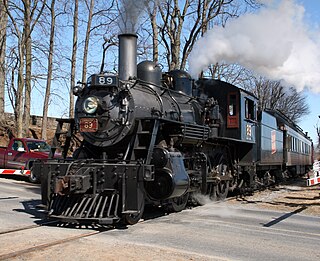
Under the Whyte notation for the classification of steam locomotives, 2-6-0 represents the wheel arrangement of two leading wheels on one axle, usually in a leading truck, six powered and coupled driving wheels on three axles and no trailing wheels. This arrangement is commonly called a Mogul.

The British Rail Class 98 is a Total Operations Processing System (TOPS) classification that has been used to cover all steam locomotives used on the mainline in Britain, but also has a particular usage for the three Vale of Rheidol Railway-design 2-6-2T locomotives that remained in the ownership of British Rail (BR) after the end of mainline steam traction in August 1968. The locomotives on the Vale of Rheidol Railway were the only steam locomotives ever officially to carry the British Rail corporate blue and the double arrow logo.

The BR Standard Class 7, otherwise known as the Britannia Class, is a class of 4-6-2 Pacific steam locomotive designed under Robert Riddles for use by British Railways for mixed-traffic duties. 55 were constructed between 1951 and 1954. The design employed results from the 1948 locomotive exchanges undertaken in advance of further locomotive classes being constructed. Three batches were constructed at Crewe Works, before the publication of the 1955 Modernisation Plan.
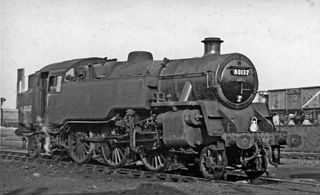
The British Railways Standard Class 4 tank is a class of steam locomotive, one of the BR standard classes built during the 1950s. They were used primarily on commuter and outer suburban services. They were capable of reaching speeds of 75 mph (121 km/h).
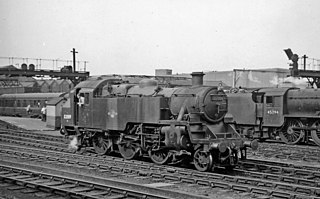
The BR Standard Class 3 2-6-2T was a class of steam locomotive designed by Robert Riddles for British Railways. It was essentially a hybrid design, the chassis being closely based on and sharing a number of parts with the LMS Ivatt Class 4, and having a boiler derived from a GWR No.2 boiler as fitted to the GWR Large Prairie 2-6-2T and 5600 Class 0-6-2T tank engines.
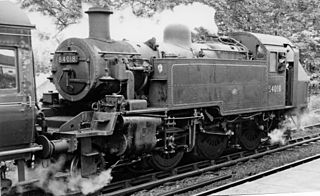
The British Railways standard class 2 2-6-2T was a class of steam locomotive, one of the standard classes of the 1950s.

The London Midland and Scottish Railway (LMS) Fairburn Tank 2-6-4T is a class of steam locomotive. They were designed by Charles E. Fairburn for the LMS. 277 of these locomotives were built between 1945 and 1951, numbered in the range 42050–42186, (4)2187–(4)2299, (4)2673–(4)2699.

The London Midland and Scottish Railway's class 8F is a class of steam locomotive designed for hauling heavy freight. 852 were built between 1935 and 1946, as a freight version of William Stanier's successful Black Five, and the class saw extensive service overseas during and after the Second World War.
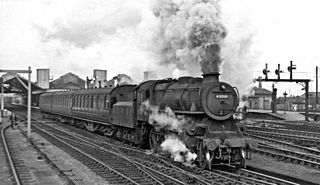
The LMS Ivatt Class 4 2-6-0 is a class of steam locomotive primarily designed for medium freight work but also widely used on secondary passenger services. The London Midland and Scottish Railway (LMS) ordered 162 of this type between 1947 and 1952, but only three were built by the LMS before nationalisation in 1948. Designed by George Ivatt, they were classified 4F by the LMS and 4MT by BR. In BR days they were used extensively across the system, being prevalent on the London Midland region and to a lesser extent elsewhere, notably on the Midland and Great Northern Joint Railway, an East Anglian line that had previously been joint owned by the LMS and LNER, where they became the dominant locomotive type. They were also used for a short period on the Somerset and Dorset Joint Railway, but were quickly transferred elsewhere, never to return, because of poor steaming on the line's long and steep gradients – this was before modifications were made to the design which improved steaming notably.

The London, Midland and Scottish Railway (LMS) Ivatt Class 2 2-6-2T is a class of light 'mixed-traffic' steam locomotive introduced in 1946.

Crewe Works is a British railway engineering facility located in the town of Crewe, Cheshire. The works, which was originally opened by the Grand Junction Railway in 1840, employed up to 20,000 workers at its peak. In the 1980s, a lot of the engineering works were closed. Much of the site has been redeveloped but the remaining parts are owned and operated by French-owned multinational rolling stock manufacturer, Alstom SA.

The London Midland and Scottish Railway (LMS) Fowler 3F0-6-0T is a class of steam locomotive, often known as Jinty. They represent the ultimate development of the Midland Railway's six-coupled tank engines. They could reach speeds of up to 60 mph (97 km/h).

The London Midland and Scottish Railway (LMS) Fowler Class 4F is a class of 0-6-0 steam locomotive designed for medium freight work. They represent the ultimate development of Midland Railway's six coupled tender engines. Many trainspotters knew them as "Duck Sixes", a nickname derived from their wheel arrangement.

The BR Standard Class 3 2-6-0 was a class of mixed traffic steam locomotive designed by Robert Riddles for British Railways. It was essentially a hybrid design, the chassis being closely based on and sharing a number of parts with the LMS Ivatt Class 4, and having a boiler derived from a GWR No.2 boiler as fitted to the GWR Large Prairie 2-6-2T and 5600 Class 0-6-2T tank engines.

London and North Eastern Railway (LNER) Thompson Class B1 No. 1264, is a preserved British steam locomotive.
References
- Pat Rowledge Locomotives of the LMS built 1923-1951
- Hugh Longworth British Railway (sic) Steam Locomotives 1948-68